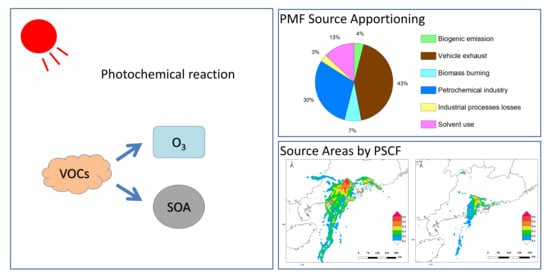Volatile Organic Compounds Monitored Online at Three Photochemical Assessment Monitoring Stations in the Pearl River Delta (PRD) Region during Summer 2016: Sources and Emission Areas
Abstract
1. Introduction
2. Methods
2.1. Desciption of Monitoring Sites
2.2. Online Measurement of VOCs
2.3. Data Collection
2.4. Data Analysis
2.4.1. PMF Receptor Model
2.4.2. Potential Source Contribution Function (PSCF)
2.4.3. Ozone Formation Potential (OFP)
2.4.4. Secondary Organic Aerosol Formation Potential (SOAFP)
3. Results and Discussion
3.1. Variations in Mixing Ratios of VOCs
3.2. Compositions and Contributions to OFP and SOAFP
3.3. Source Attributions by PMF
3.4. Source Areas by PSCF Analysis
4. Conclusions
Author Contributions
Funding
Institutional Review Board Statement
Informed Consent Statement
Data Availability Statement
Acknowledgments
Conflicts of Interest
References
- Sillman, S. The relation between ozone, NOx and hydrocarbons in urban and polluted rural environments. Atmos. Environ. 1999, 33, 1821–1845. [Google Scholar] [CrossRef]
- Wang, B.; Shao, M.; Lu, S.H.; Yuan, B.; Zhao, Y.; Wang, M.; Zhang, S.Q.; Wu, D. Variation of ambient non-methane hydrocarbons in Beijing city in summer 2008. Atmos. Chem. Phys. 2010, 10, 5911–5923. [Google Scholar] [CrossRef]
- Cheng, H.R.; Saunders, S.M.; Guo, H.; Louie, P.K.K.; Jiang, F. Photochemical trajectory modeling of ozone concentrations in Hong Kong. Environ. Pollut. 2013, 180, 101–110. [Google Scholar] [CrossRef] [PubMed]
- Liu, X.H.; Zhang, Y.; Xing, J.; Zhang, Q.; Wang, K.; Streets, D.G.; Jang, C.; Wang, W.-X.; Hao, J.M. Understanding of Regional Air Pollution over China Using Cmaq, Part Ii. Process Analysis and Sensitivity of Ozone and Particulate Matter to Precursor Emissions. Atmos. Environ. 2010, 44, 3719–3727. [Google Scholar] [CrossRef]
- Wei, W.; Cheng, S.; Li, G.; Wang, G.; Wang, H. Characteristics of Volatile Organic Compounds (VOCs) Emitted from a Petroleum Refinery in Beijing, China. Atmos. Environ. 2014, 89, 358–366. [Google Scholar] [CrossRef]
- Jang, M.S.; Czoschke, N.M.; Lee, S.; Kamens, R.M. Heterogeneous Atmospheric Aerosol Production by Acid-Catalyzed Particle-Phase Reactions. Science 2002, 298, 814–817. [Google Scholar] [CrossRef]
- Claeys, M.; Graham, B.; Vas, G.; Wang, W.; Vermeylen, R.; Pashynska, V.; Cafmeyer, J.; Guyon, P.; Andreae, M.O.; Artaxo, P.; et al. Formation of Secondary Organic Aerosols through Photooxidation of Isoprene. Science 2004, 303, 1173–1176. [Google Scholar] [CrossRef] [PubMed]
- Cabada, J.C.; Pandis, S.N.; Subramanian, R.; Robinson, A.L.; Polidori, A.; Turpin, B. Estimating the Secondary Organic Aerosol Contribution to PM2.5 using the EC Tracer Method Special Issue Of aerosol Science and Technologyon Findings from the Fine Particulate Matter Supersites Program. Aerosol Sci. Technol. 2004, 38, 140–155. [Google Scholar] [CrossRef]
- Lonati, G.; Giugliano, M.; Butelli, P.; Romele, L.; Tardivo, R. Major Chemical Components of PM2.5 in Milan (Italy). Atmos. Environ. 2005, 39, 1925–1934. [Google Scholar] [CrossRef]
- Zou, Y.; Deng, X.J.; Zhu, D.; Gong, D.C.; Wang, H.; Li, F.; Tan, H.B.; Deng, T.; Mai, B.R.; Liu, X.T.; et al. Characteristics of 1 Year of Observational Data of VOCs, NOx and O3 at a Suburban Site in Guangzhou, China. Atmos. Chem. Phys. 2015, 15, 6625–6636. [Google Scholar] [CrossRef]
- Shao, M.; Zhang, Y.; Zeng, L.; Tang, X.; Zhang, J.; Zhong, L.; Wang, B. Ground-Level Ozone in the Pearl River Delta and the Roles of VOC and NO(X) in Its Production. J. Environ. Manag. 2009, 90, 512–518. [Google Scholar] [CrossRef] [PubMed]
- Xue, L.; Wang, T.; Louie, P.K.K.; Luk, C.W.Y.; Blake, D.R.; Xu, Z. Increasing External Effects Negate Local Efforts to Control Ozone Air Pollution: A Case Study of Hong Kong and Implications for Other Chinese Cities. Environ. Sci. Technol. 2014, 48, 10769–10775. [Google Scholar] [CrossRef] [PubMed]
- Xue, L.K.; Wang, T.; Gao, J.; Ding, A.J.; Zhou, X.H.; Blake, D.R.; Wang, X.F.; Saunders, S.M.; Fan, S.J.; Zuo, H.C.; et al. Ground-Level Ozone in Four Chinese Cities: Precursors, Regional Transport and Heterogeneous Processes. Atmos. Chem. Phys. 2014, 14, 13175–13188. [Google Scholar] [CrossRef]
- Ling, Z.H.; Guo, H.; Cheng, H.R.; Yu, Y.F. Sources of Ambient Volatile Organic Compounds and Their Contributions to Photochemical Ozone Formation at a Site in the Pearl River Delta, Southern China. Environ. Pollut. 2011, 159, 2310–2319. [Google Scholar] [CrossRef]
- Guo, H.; Ling, Z.; Cheung, K.; Jiang, F.; Wang, D.; Simpson, I.; Barletta, B.; Meinardi, S.; Wang, T.; Wang, X. Characterization of Photochemical Pollution at Different Elevations in Mountainous Areas in Hong Kong. Atmos. Chem. Phys. 2013, 13, 3881–3898. [Google Scholar] [CrossRef]
- Bo, Y.; Cai, H.; Xie, S.D. Spatial and Temporal Variation of Historical Anthropogenic NMVOCs Emission Inventories in China. Atmos. Chem. Phys. 2008, 8, 7297–7316. [Google Scholar] [CrossRef]
- Zheng, J.; Zhang, L.; Che, W.; Zheng, Z.; Yin, S. A Highly Resolved Temporal and Spatial Air Pollutant Emission Inventory for the Pearl River Delta Region, China and Its Uncertainty Assessment. Atmos. Environ. 2009, 43, 5112–5122. [Google Scholar] [CrossRef]
- Guo, H.; Cheng, H.R.; Ling, Z.H.; Louie, P.K.; Ayoko, G.A. Which Emission Sources Are Responsible for the Volatile Organic Compounds in the Atmosphere of Pearl River Delta? J. Hazard Mater. 2011, 188, 116–124. [Google Scholar] [CrossRef]
- Yuan, B.; Chen, W.; Shao, M.; Wang, M.; Lu, S.; Wang, B.; Liu, Y.; Chang, C.-C.; Wang, B. Measurements of Ambient Hydrocarbons and Carbonyls in the Pearl River Delta (PRD), China. Atmospheric Res. 2012, 116, 93–104. [Google Scholar] [CrossRef]
- Zhang, Y.; Wang, X.; Barletta, B.; Simpson, I.J.; Blake, D.R.; Fu, X.; Zhang, Z.; He, Q.; Liu, T.; Zhao, X.; et al. Source Attributions of Hazardous Aromatic Hydrocarbons in Urban, Suburban and Rural Areas in the Pearl River Delta (PRD) Region. J. Hazard. Mater. 2013, 250–251, 403–411. [Google Scholar] [CrossRef]
- Zhang, Y.; Wang, X.; Zhang, Z.; Lü, S.; Shao, M.; Lee, F.S.C.; Yu, J. Species Profiles and Normalized Reactivity of Volatile Organic Compounds from Gasoline Evaporation in China. Atmos. Environ. 2013, 79, 110–118. [Google Scholar] [CrossRef]
- Ou, J.; Guo, H.; Zheng, J.; Cheung, K.; Louie, P.K.K.; Ling, Z.; Wang, D. Concentrations and Sources of Non-Methane Hydrocarbons (NMHCs) from 2005 to 2013 in Hong Kong: A Multi-Year Real-Time Data Analysis. Atmos. Environ. 2015, 103, 196–206. [Google Scholar] [CrossRef]
- Zhang, Y.; Wang, X.; Zhang, Z.; Lu, S.; Huang, Z.; Li, L. Sources of C2-C4 Alkenes, the Most Important Ozone Nonmethane Hydrocarbon Precursors in the Pearl River Delta Region. Sci. Total Environ. 2015, 502, 236–245. [Google Scholar] [CrossRef]
- Guo, H.; Wang, T.; Blake, D.R.; Simpson, I.J.; Kwok, Y.H.; Li, Y.S. Regional and Local Contributions to Ambient Non-Methane Volatile Organic Compounds at a Polluted Rural/Coastal Site in Pearl River Delta, China. Atmos. Environ. 2006, 40, 2345–2359. [Google Scholar] [CrossRef]
- Ashbaugh, L.L.; Malm, W.C.; Sadeh, W.Z. A Residence Time Probability Analysis of Sulfur Concentrations at Grand Canyon National Park. Atmos. Environ. 1985, 19, 1263–1270. [Google Scholar] [CrossRef]
- Draxler, R.R.; Hess, G.D. An Overview of the Hysplit_4 Modelling System for Trajectories, Dispersion and Deposition. Aust. Meteorol. Mag. 1998, 47, 295–308. [Google Scholar]
- Polissar, A.V.; Hopke, P.K.; Paatero, P.; Kaufmann, Y.J.; Hall, D.K.; Bodhaine, B.A.; Dutton, E.G.; Harris, J.M. The Aerosol at Barrow, Alaska: Long-Term Trends and Source Locations. Atmos. Environ. 1999, 33, 2441–2458. [Google Scholar] [CrossRef]
- Paatero, P.; Tapper, U. Positive Matrix Factorization—A Nonnegative Factor Model with Optimal Utilization of Error-Estimates of Data Values. Environmetrics 1994, 5, 111–126. [Google Scholar] [CrossRef]
- Paatero, P. Least Squares Formulation of Robust Non-Negative Factor Analysis. Chemom. Intell. Lab. Syst. 1997, 37, 23–35. [Google Scholar] [CrossRef]
- Norris, G.; Duvall, R.; Brown, S.; Bai, S. EPA Positive Matrix Factorization (PMF) 5.0 Fundamentals and User Guide; U.S. Environmental Protection Agency, Office of Research and Development: Washington, DC, USA, 2014. [Google Scholar]
- Brown, S.G.; Frankel, A.; Hafner, H.R. Source Apportionment of VOCs in the Los Angeles Area Using Positive Matrix Factorization. Atmos. Environ. 2007, 41, 227–237. [Google Scholar] [CrossRef]
- Polissar, A.V.; Hopke, P.K.; Paatero, P. Atmospheric Aerosol over Alaska—2. Elemental Composition and Sources. J. Geophys. Res. Atmos. 1998, 103, 19045–19057. [Google Scholar] [CrossRef]
- Reff, A.; Eberly, S.I.; Bhave, P.V. Receptor Modeling of Ambient Particulate Matter Data Using Positive Matrix Factorization: Review of Existing Methods. J. Air Waste Manag. Assoc. 2007, 57, 146–154. [Google Scholar] [CrossRef]
- Wang, Y.Q.; Zhang, X.Y.; Draxler, R.R. Trajstat: Gis-Based Software That Uses Various Trajectory Statistical Analysis Methods to Identify Potential Sources from Long-Term Air Pollution Measurement Data. Environ. Model. Softw. 2009, 24, 938–939. [Google Scholar] [CrossRef]
- Carter, W.P. Updated Maximum Incremental Reactivity Scale and Hydrocarbon Bin Reactivities for Regulatory Applications. Calif. Air Resour. Board Contract 2009, 339. Available online: http://citeseerx.ist.psu.edu/viewdoc/download?doi=10.1.1.480.5788&rep=rep1&type=pdf (accessed on 7 February 2021).
- Grosjean, D.; Seinfeld, J.H. Parameterization of the Formation Potential of Secondary Organic Aerosols. Atmos. Environ. 1989, 23, 1733–1747. [Google Scholar] [CrossRef]
- Grosjean, D. In Situ Organic Aerosol Formation During a Smog Episode: Estimated Production and Chemical Functionality. Atmos. Environ. Part A Gen. Top. 1992, 26, 953–963. [Google Scholar] [CrossRef]
- Tang, J.H.; Chan, L.Y.; Chang, C.C.; Liu, S.; Li, Y.S. Characteristics and Sources of Non-Methane Hydrocarbons in Background Atmospheres of Eastern, Southwestern, and Southern China. J. Geophys. Res. 2009, 114. [Google Scholar] [CrossRef]
- Zhu, Y.; Yang, L.; Chen, J.; Wang, X.; Xue, L.; Sui, X.; Wen, L.; Xu, C.; Yao, L.; Zhang, J.; et al. Characteristics of Ambient Volatile Organic Compounds and the Influence of Biomass Burning at a Rural Site in Northern China During Summer 2013. Atmos. Environ. 2016, 124, 156–165. [Google Scholar] [CrossRef]
- He, Z.; Wang, X.; Ling, Z.; Zhao, J.; Guo, H.; Shao, M.; Wang, Z. Contributions of Different Anthropogenic Volatile Organic Compound Sources to Ozone Formation at a Receptor Site in the Pearl River Delta Region and Its Policy Implications. Atmos. Chem. Phys. 2019, 19, 8801–8816. [Google Scholar] [CrossRef]
- Zhang, Y.; Yang, W.; Simpson, I.; Huang, X.; Yu, J.; Huang, Z.; Wang, Z.; Zhang, Z.; Liu, D.; Huang, Z.; et al. Decadal Changes in Emissions of Volatile Organic Compounds (VOCs) from on-Road Vehicles with Intensified Automobile Pollution Control: Case Study in a Busy Urban Tunnel in South China. Environ. Pollut. 2018, 233, 806–819. [Google Scholar] [CrossRef]
- Zheng, J.; Yu, Y.; Mo, Z.; Zhang, Z.; Wang, X.; Yin, S.; Peng, K.; Yang, Y.; Feng, X.; Cai, H. Industrial Sector-Based Volatile Organic Compound (VOC) Source Profiles Measured in Manufacturing Facilities in the Pearl River Delta, China. Sci. Total Environ. 2013, 456–457, 127–136. [Google Scholar] [CrossRef] [PubMed]
- Cai, C.; Geng, F.; Tie, X.; Yu, Q.; An, J. Characteristics and Source Apportionment of VOCs Measured in Shanghai, China. Atmos. Environ. 2010, 44, 5005–5014. [Google Scholar] [CrossRef]
- An, J.; Wang, J.; Zhang, Y.; Zhu, B. Source Apportionment of Volatile Organic Compounds in an Urban Environment at the Yangtze River Delta, China. Arch. Environ. Contam. Toxicol. 2017, 72, 335–348. [Google Scholar] [CrossRef] [PubMed]
- Huang, X.F.; Wang, C.; Zhu, B.; Lin, L.L.; He, L.Y. Exploration of Sources of Ovocs in Various Atmospheres in Southern China. Environ. Pollut. 2019, 249, 831–842. [Google Scholar] [CrossRef] [PubMed]
- Ma, Z.; Liu, C.; Zhang, C.; Liu, P.; Ye, C.; Xue, C.; Zhao, D.; Sun, J.; Du, Y.; Chai, F.; et al. The Levels, Sources and Reactivity of Volatile Organic Compounds in a Typical Urban Area of Northeast China. J. Environ. Sci. 2019, 79, 121–134. [Google Scholar] [CrossRef] [PubMed]
- Song, C.; Liu, B.; Dai, Q.; Li, H.; Mao, H. Temperature Dependence and Source Apportionment of Volatile Organic Compounds (VOCs) at an Urban Site on the North China Plain. Atmos. Environ. 2019, 207, 167–181. [Google Scholar] [CrossRef]
- Li, Y.; Yin, S.; Yu, S.; Yuan, M.; Dong, Z.; Zhang, D.; Yang, L.; Zhang, R. Characteristics, Source Apportionment and Health Risks of Ambient VOCs During High Ozone Period at an Urban Site in Central Plain, China. Chemosphere 2020, 250, 126283. [Google Scholar] [CrossRef]
- Huang, C.; Wang, H.L.; Li, L.; Wang, Q.; Lu, Q.; De Gouw, J.A.; Zhou, M.; Jing, S.A.; Lu, J.; Chen, C.H. VOC Species and Emission Inventory from Vehicles and Their SOA Formation Potentials Estimation in Shanghai, China. Atmos. Chem. Phys. 2015, 15, 11081–11096. [Google Scholar] [CrossRef]
- Li, Q.; Su, G.; Li, C.; Liu, P.; Zhao, X.; Zhang, C.; Sun, X.; Mu, Y.; Wu, M.; Wang, Q.; et al. An Investigation into the Role of VOCs in SOA and Ozone Production in Beijing, China. Sci. Total Environ. 2020, 720, 137536. [Google Scholar] [CrossRef]
- Tan, Q.; Liu, H.; Xie, S.; Zhou, L.; Song, T.; Shi, G.; Jiang, W.; Yang, F.; Wei, F. Temporal and Spatial Distribution Characteristics and Source Origins of Volatile Organic Compounds in a Megacity of Sichuan Basin, China. Environ. Res. 2020, 185, 109478. [Google Scholar] [CrossRef] [PubMed]
- Borbon, A.; Locoge, N.; Veillerot, M.; Galloo, J.; Guillermo, R. Characterisation of NMHCs in a French Urban Atmosphere: Overview of the Main Sources. Sci. Total Environ. 2002, 292, 177–191. [Google Scholar] [CrossRef]
- Yuan, B.; Shao, M.; Lu, S.; Wang, B. Source Profiles of Volatile Organic Compounds Associated with Solvent Use in Beijing, China. Atmos. Environ. 2010, 44, 1919–1926. [Google Scholar] [CrossRef]
- Liu, Y.; Shao, M.; Lu, S.; Chang, C.C.; Wang, J.L.; Fu, L. Source Apportionment of Ambient Volatile Organic Compounds in the Pearl River Delta, China: Part Ii. Atmos. Environ. 2008, 42, 6261–6274. [Google Scholar] [CrossRef]
- Wu, F.; Yu, Y.; Sun, J.; Zhang, J.; Wang, J.; Tang, G.; Wang, Y. Characteristics, Source Apportionment and Reactivity of Ambient Volatile Organic Compounds at Dinghu Mountain in Guangdong Province, China. Sci. Total Environ. 2016, 548–549, 347–359. [Google Scholar] [CrossRef] [PubMed]
- Fang, Z.; Deng, W.; Zhang, Y.; Ding, X.; Tang, M.; Liu, T.; Hu, Q.; Zhu, M.; Wang, Z.; Yang, W.; et al. Open Burning of Rice, Corn and Wheat Straws: Primary Emissions, Photochemical Aging, and Secondary Organic Aerosol Formation. Atmos. Chem. Phys. 2017, 17, 14821–14839. [Google Scholar] [CrossRef]
- Simpson, I.J.; Blake, N.J.; Barletta, B.; Diskin, G.S.; Fuelberg, H.E.; Gorham, K.; Huey, L.G.; Meinardi, S.; Rowland, F.S.; Vay, S.A.; et al. Characterization of Trace Gases Measured over Alberta Oil Sands Mining Operations: 76 Speciated C2–C10 Volatile Organic Compounds (VOCs), CO2, CH4, CO, NO, NO2, NOY, O3 and SO2. Atmos. Chem. Phys. 2010, 10, 11931–11954. [Google Scholar] [CrossRef]
- Li, J.; Zhai, C.; Yu, J.; Liu, R.; Li, Y.; Zeng, L.; Xie, S. Spatiotemporal Variations of Ambient Volatile Organic Compounds and Their Sources in Chongqing, a Mountainous Megacity in China. Sci. Total Environ. 2018, 627, 1442–1452. [Google Scholar] [CrossRef]
- Feng, J.; Zhang, Y.; Song, W.; Deng, W.; Zhu, M.; Fang, Z.; Ye, Y.; Fang, H.; Wu, Z.; Lowther, S. Emissions of Nitrogen Oxides and Volatile Organic Compounds from Liquefied Petroleum Gas-Fueled Taxis under Idle and Cruising Modes. Environ. Pollut. 2020, 267, 115623. [Google Scholar] [CrossRef]
- Wang, Q.; Chen, C.; Wang, H.; Zhou, M.; Lou, S.; Qiao, L.; Huang, C.; Li, L.; Su, L.; Mu, Y. Forming Potential of Secondary Organic Aerosols and Sources Apportionment of VOCs in Autumn of Shanghai, China. Huanjing Kexue 2013, 34, 424–433. [Google Scholar] [PubMed]
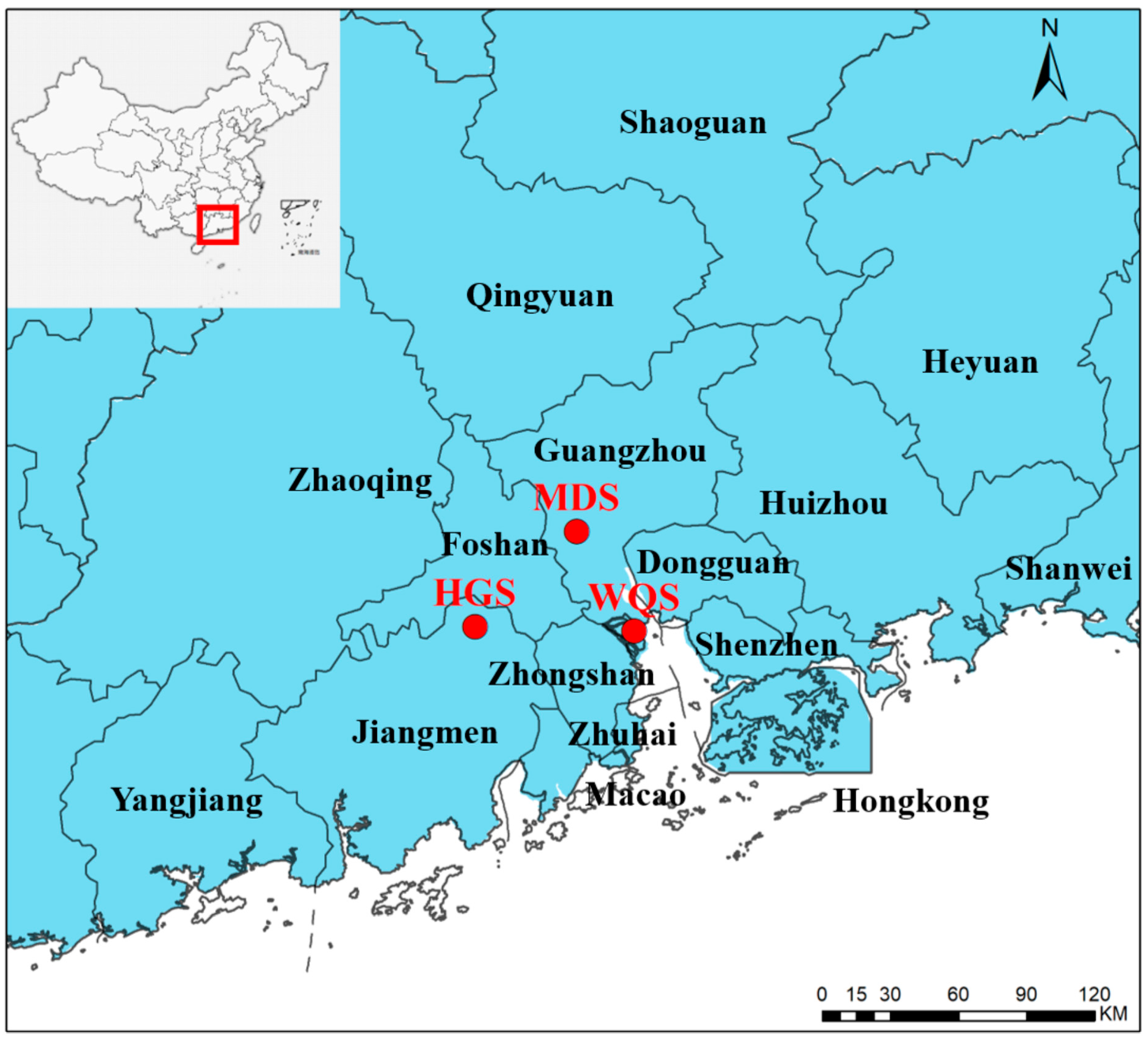
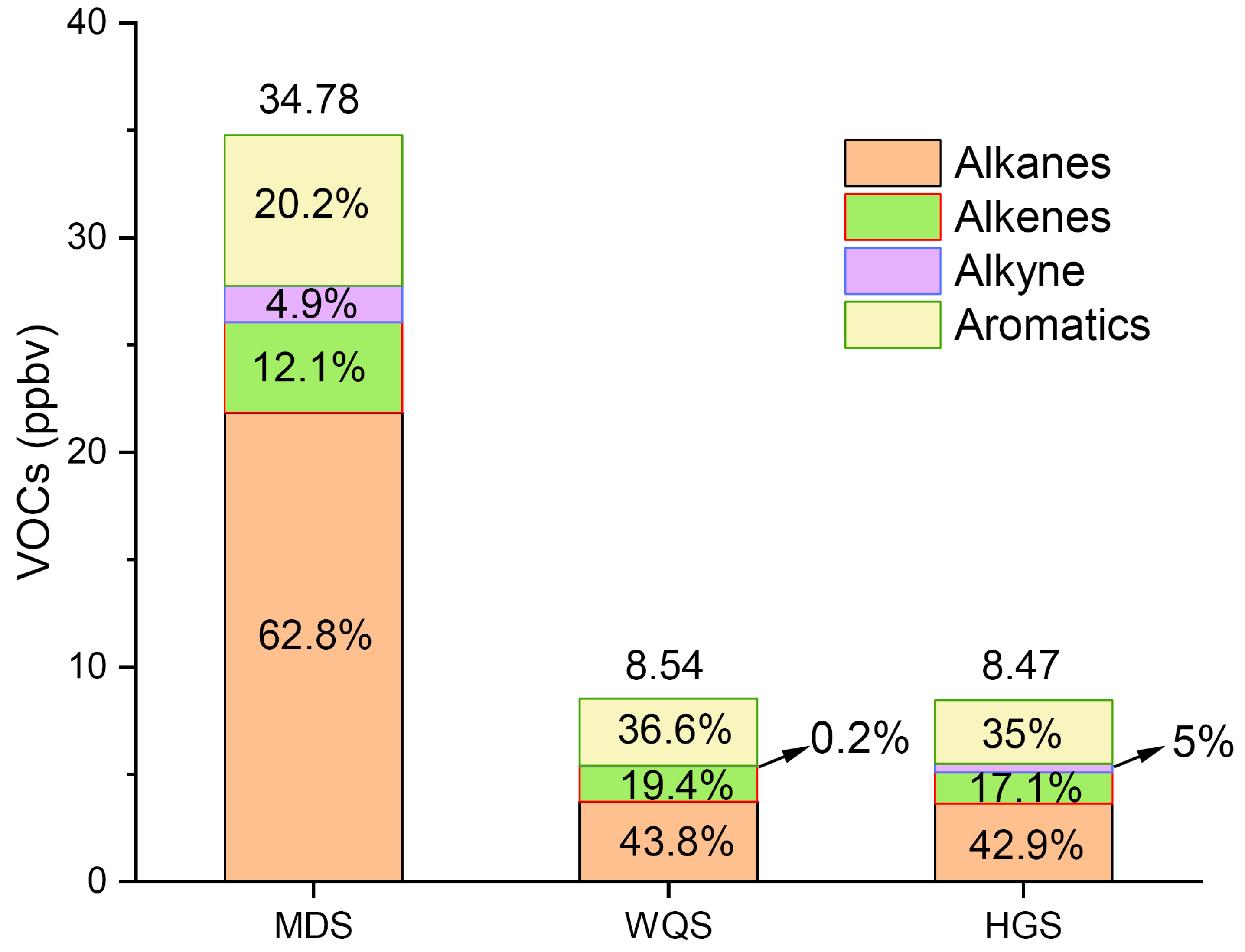
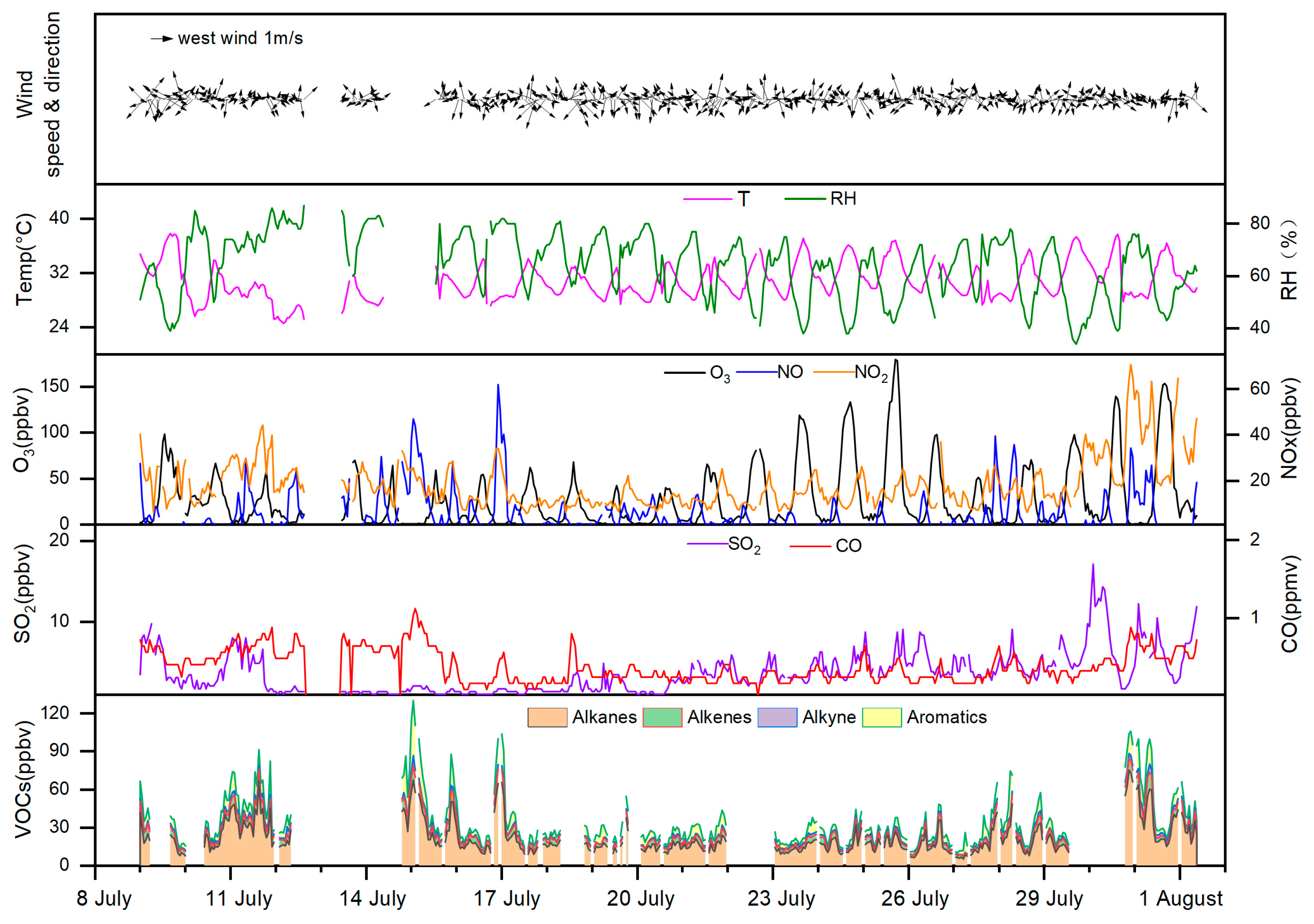

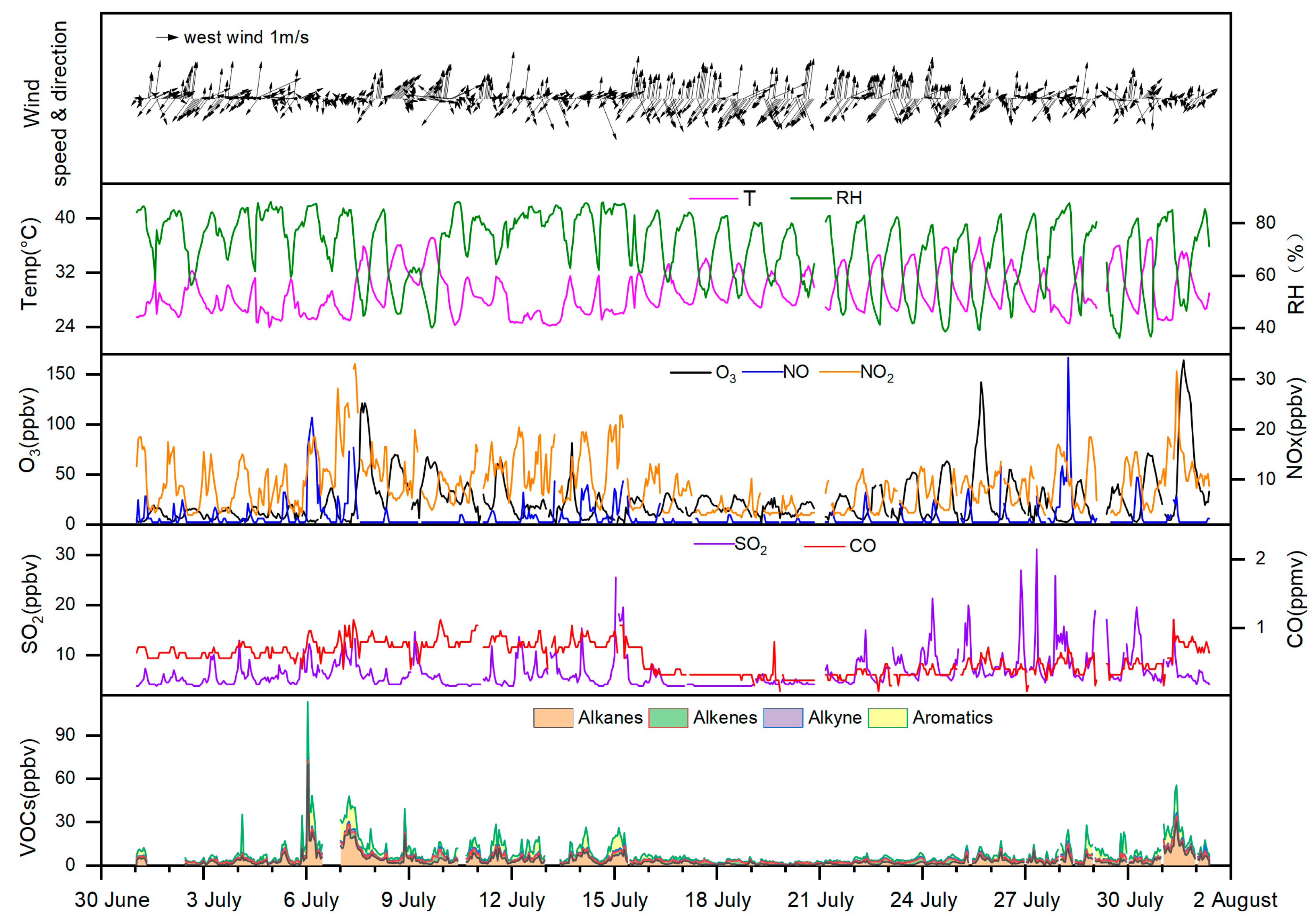


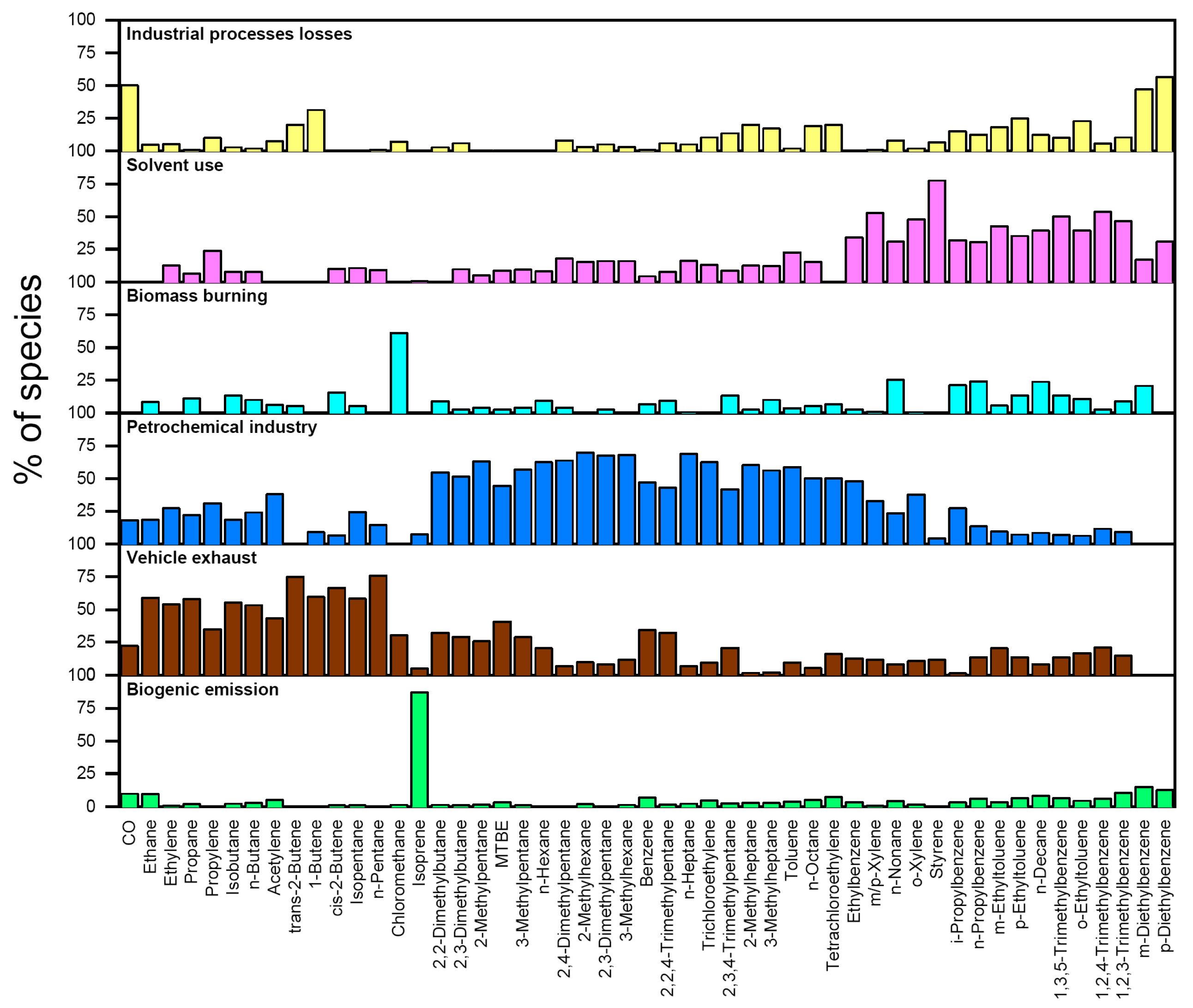

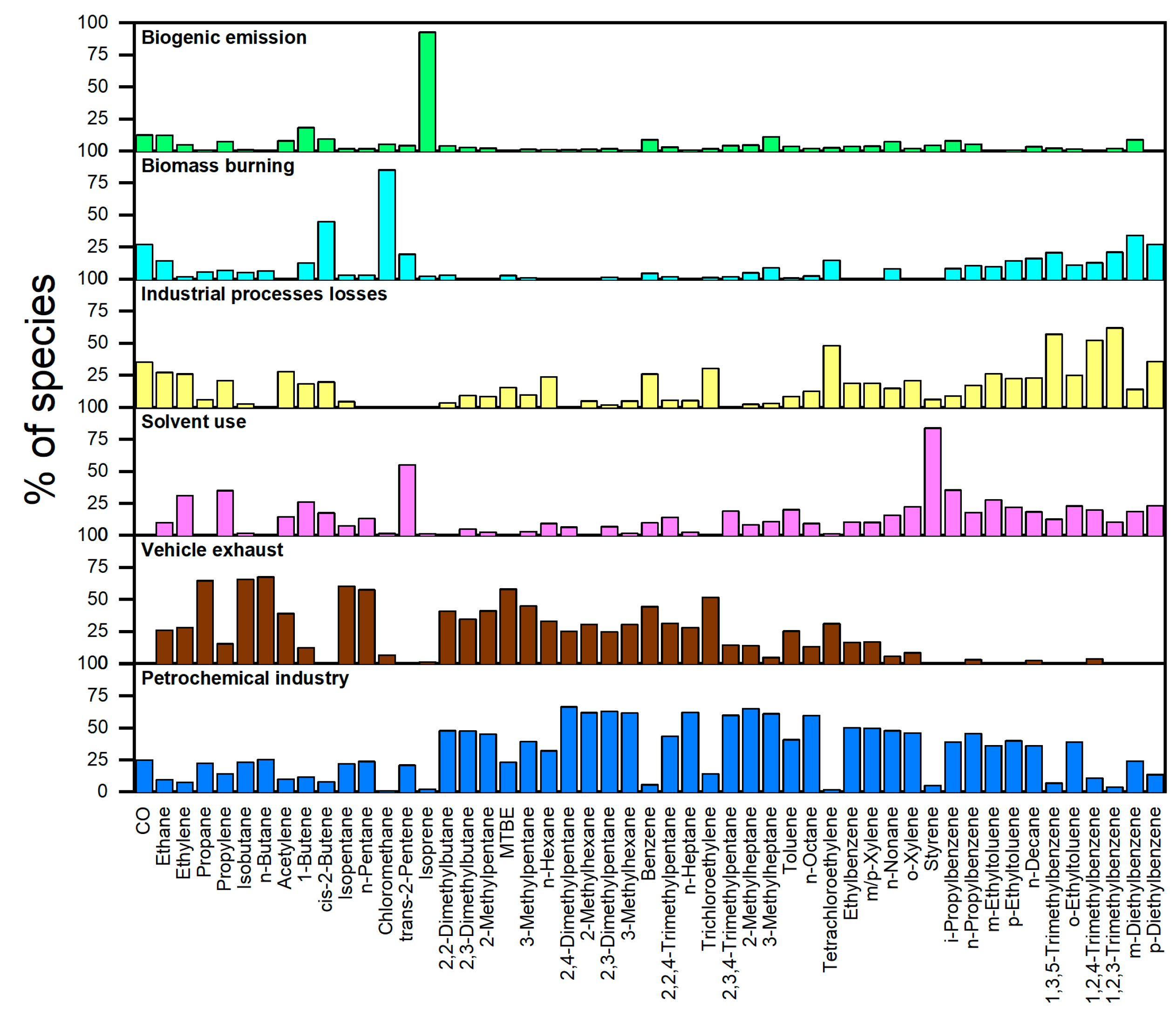
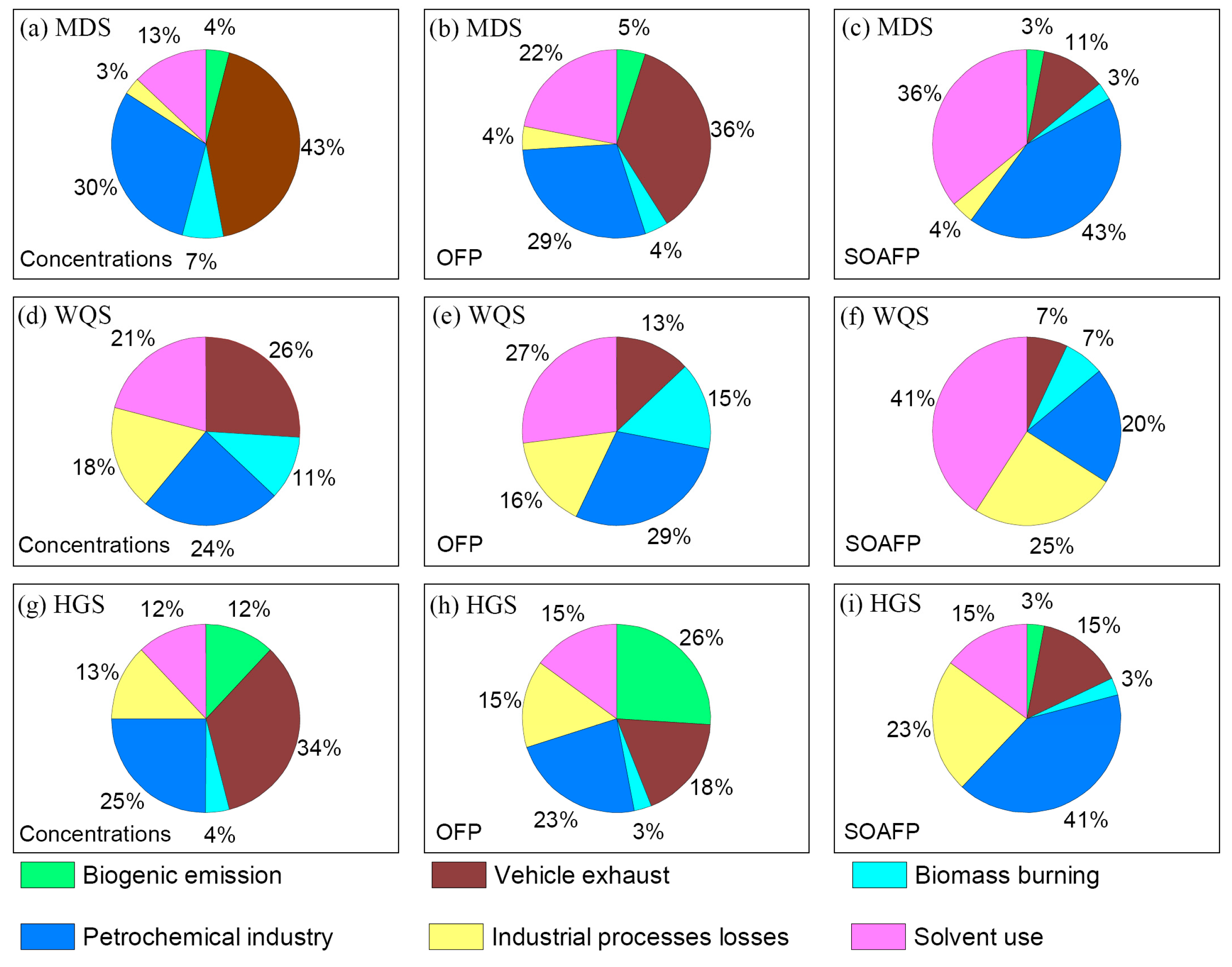

Publisher’s Note: MDPI stays neutral with regard to jurisdictional claims in published maps and institutional affiliations. |
© 2021 by the authors. Licensee MDPI, Basel, Switzerland. This article is an open access article distributed under the terms and conditions of the Creative Commons Attribution (CC BY) license (http://creativecommons.org/licenses/by/4.0/).
Share and Cite
Zhang, T.; Xiao, S.; Wang, X.; Zhang, Y.; Pei, C.; Chen, D.; Jiang, M.; Liao, T. Volatile Organic Compounds Monitored Online at Three Photochemical Assessment Monitoring Stations in the Pearl River Delta (PRD) Region during Summer 2016: Sources and Emission Areas. Atmosphere 2021, 12, 327. https://doi.org/10.3390/atmos12030327
Zhang T, Xiao S, Wang X, Zhang Y, Pei C, Chen D, Jiang M, Liao T. Volatile Organic Compounds Monitored Online at Three Photochemical Assessment Monitoring Stations in the Pearl River Delta (PRD) Region during Summer 2016: Sources and Emission Areas. Atmosphere. 2021; 12(3):327. https://doi.org/10.3390/atmos12030327
Chicago/Turabian StyleZhang, Tao, Shaoxuan Xiao, Xinming Wang, Yanli Zhang, Chenglei Pei, Duohong Chen, Ming Jiang, and Tong Liao. 2021. "Volatile Organic Compounds Monitored Online at Three Photochemical Assessment Monitoring Stations in the Pearl River Delta (PRD) Region during Summer 2016: Sources and Emission Areas" Atmosphere 12, no. 3: 327. https://doi.org/10.3390/atmos12030327
APA StyleZhang, T., Xiao, S., Wang, X., Zhang, Y., Pei, C., Chen, D., Jiang, M., & Liao, T. (2021). Volatile Organic Compounds Monitored Online at Three Photochemical Assessment Monitoring Stations in the Pearl River Delta (PRD) Region during Summer 2016: Sources and Emission Areas. Atmosphere, 12(3), 327. https://doi.org/10.3390/atmos12030327






